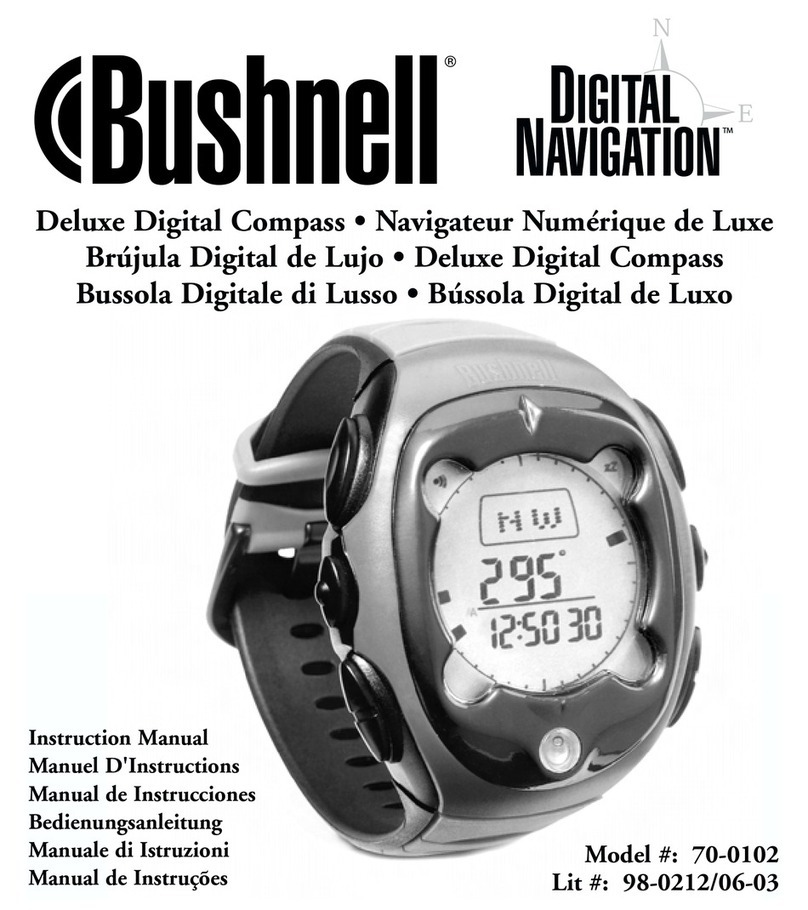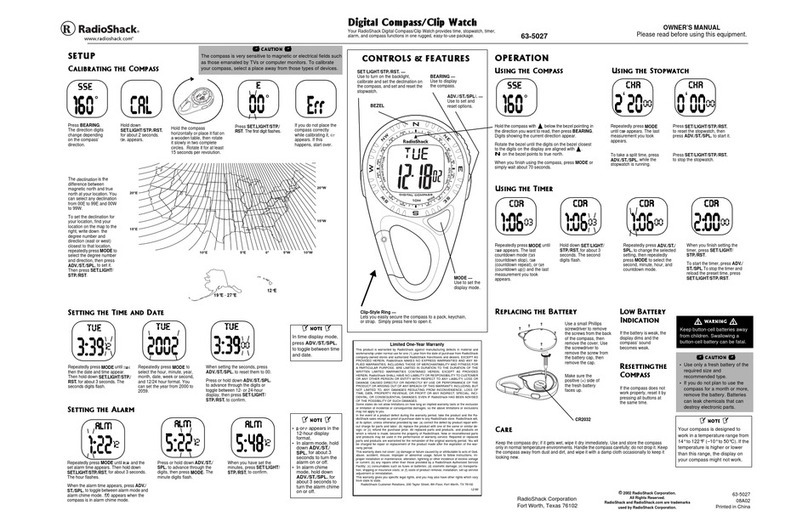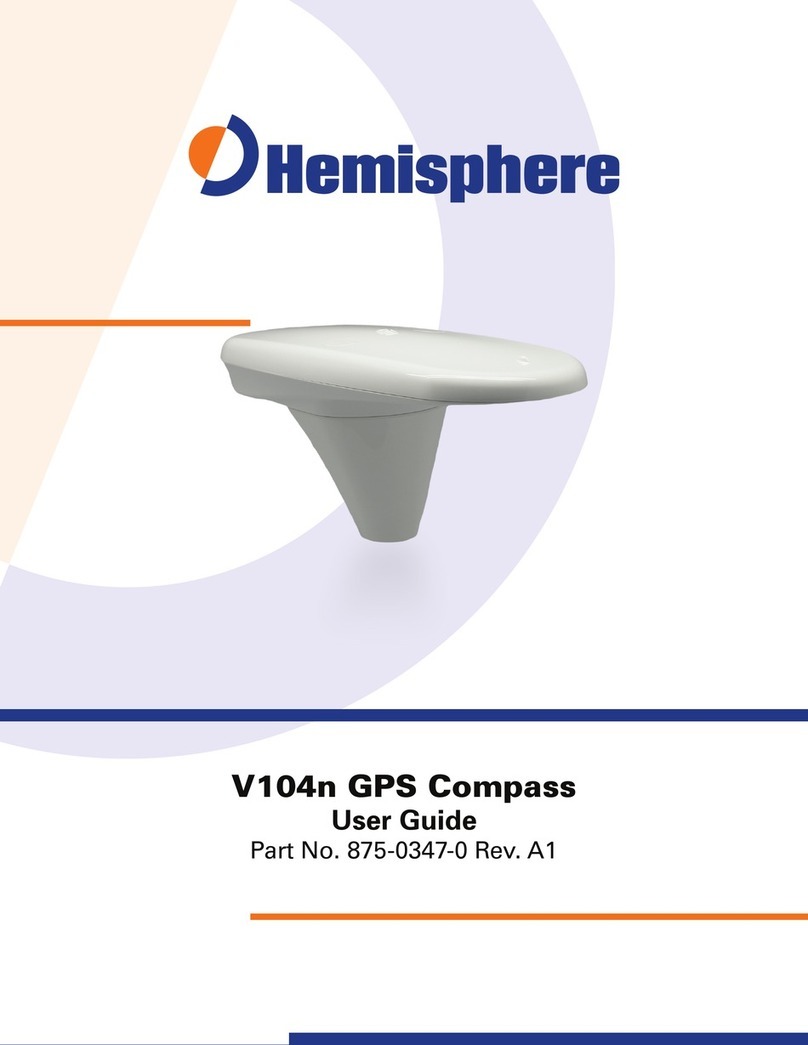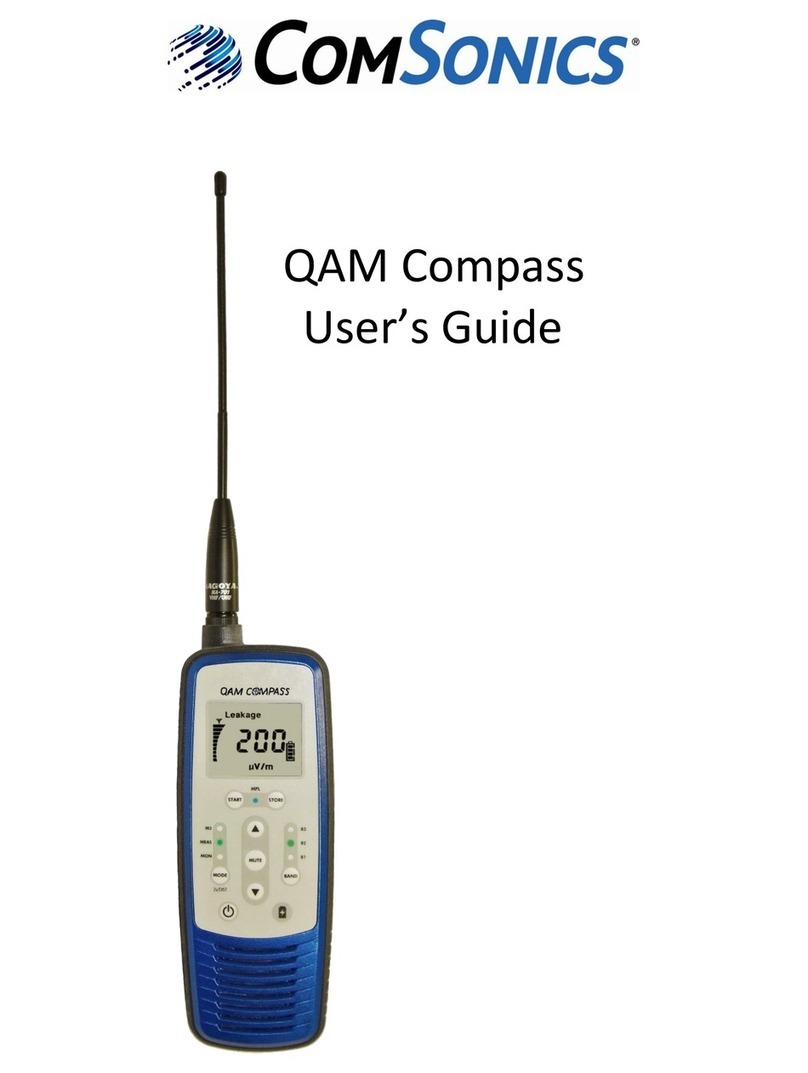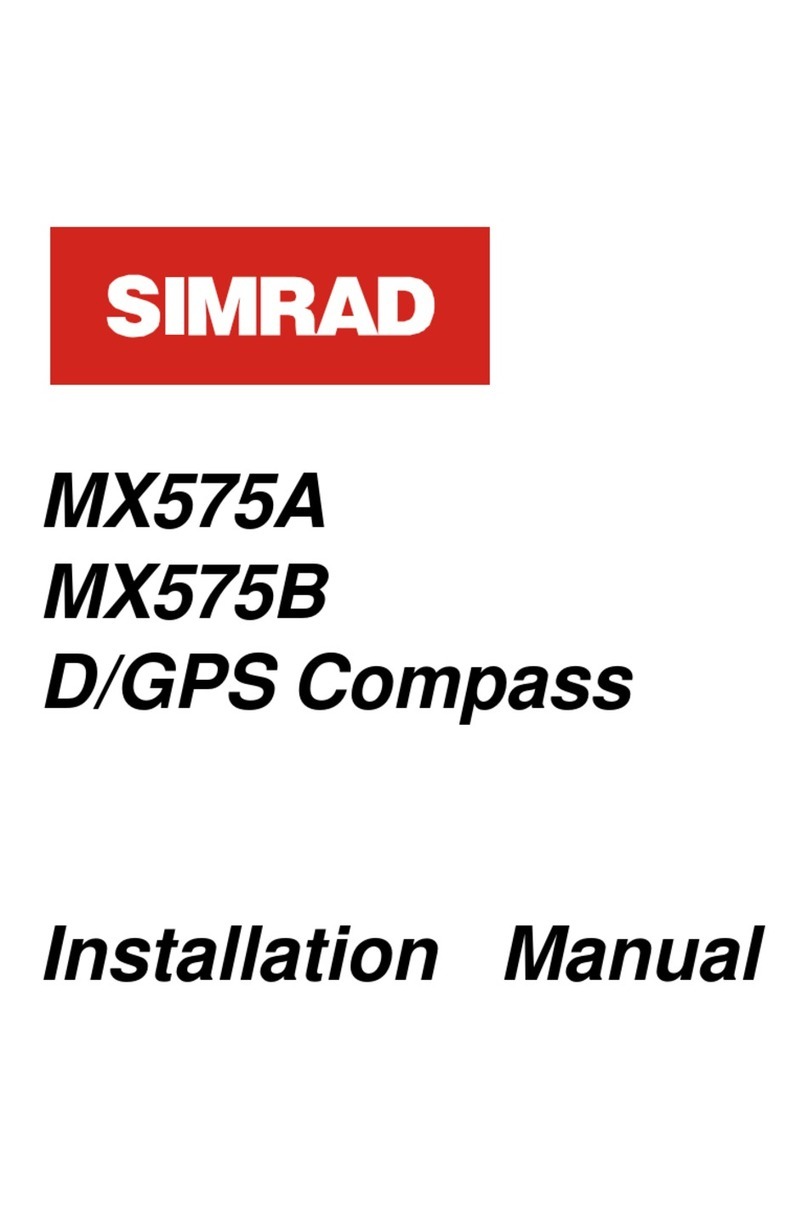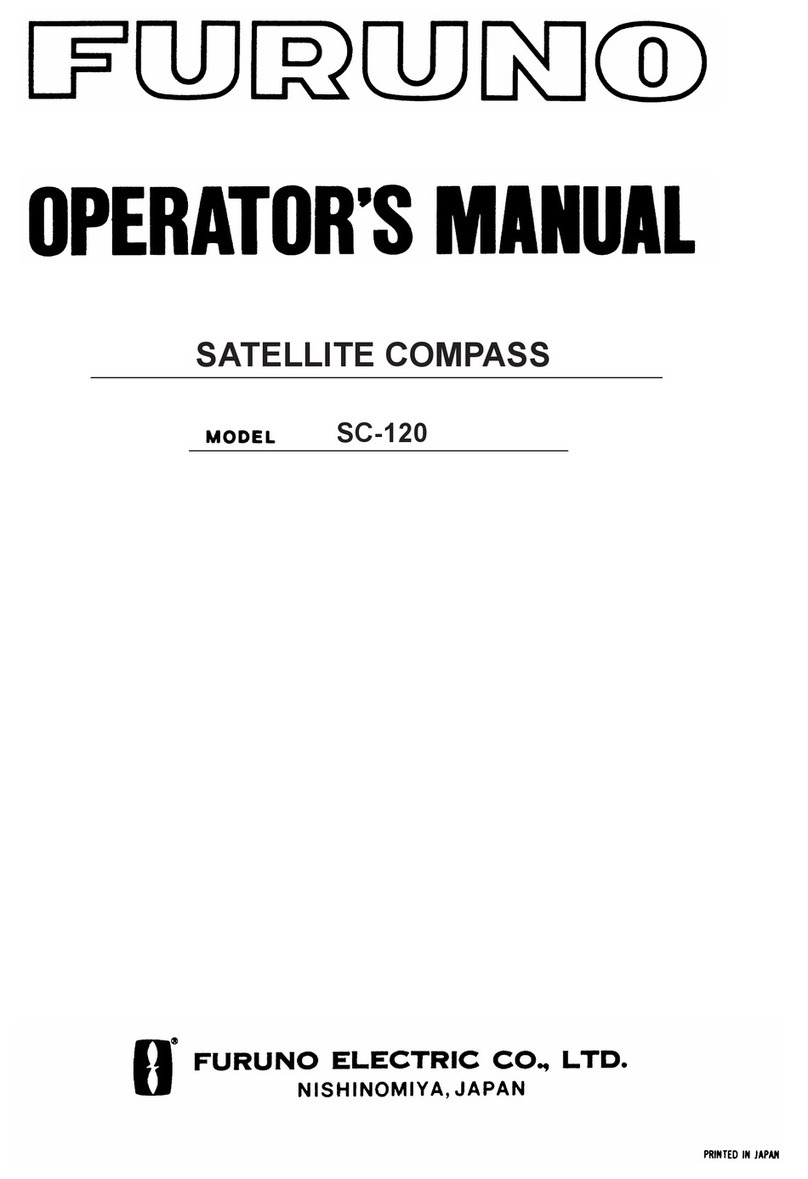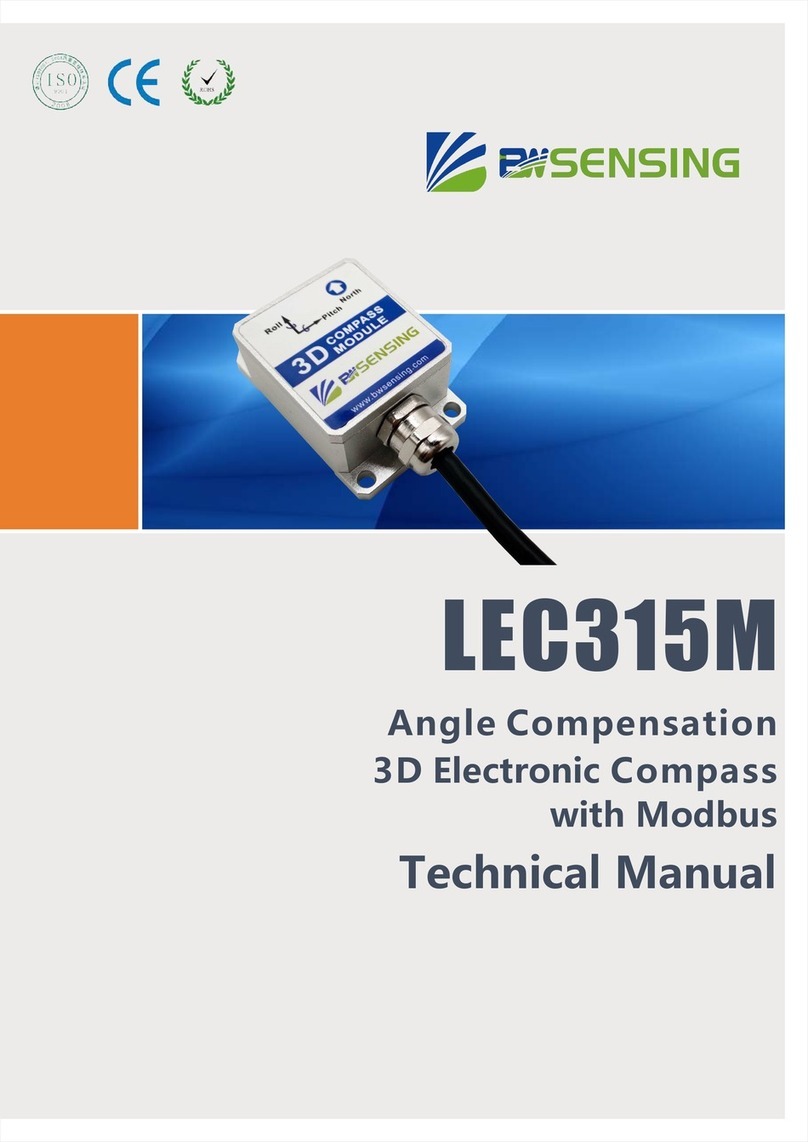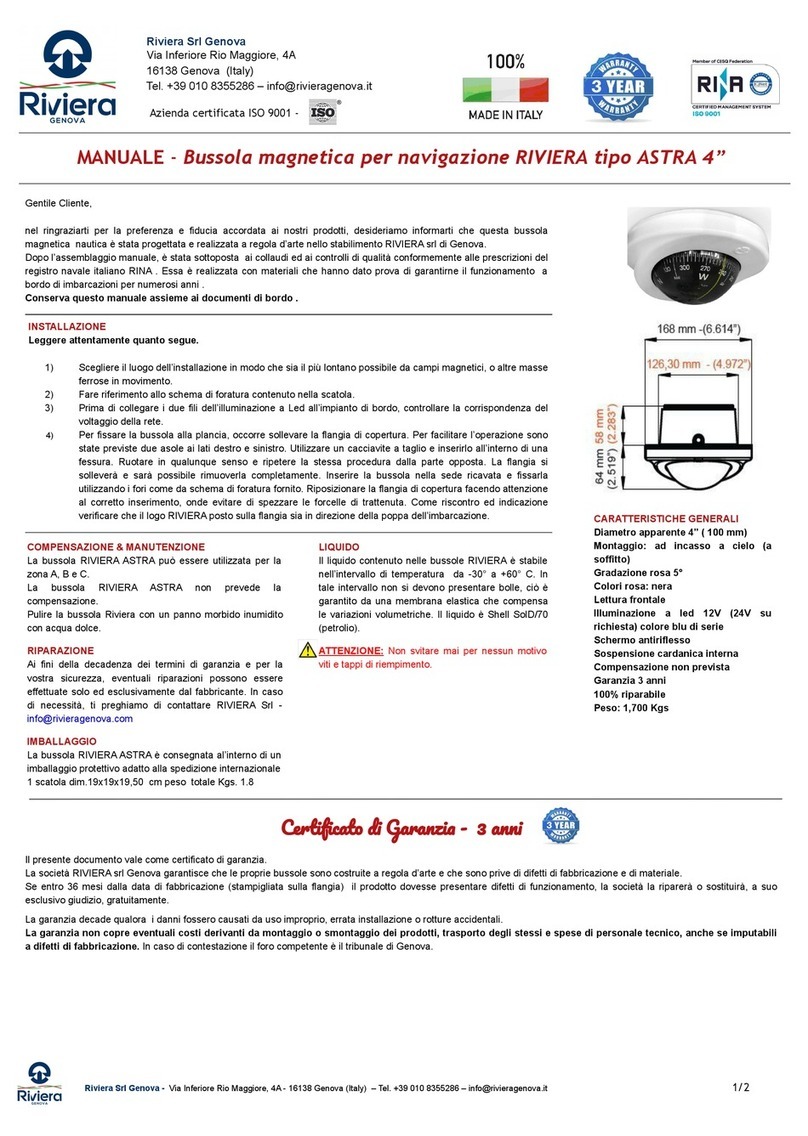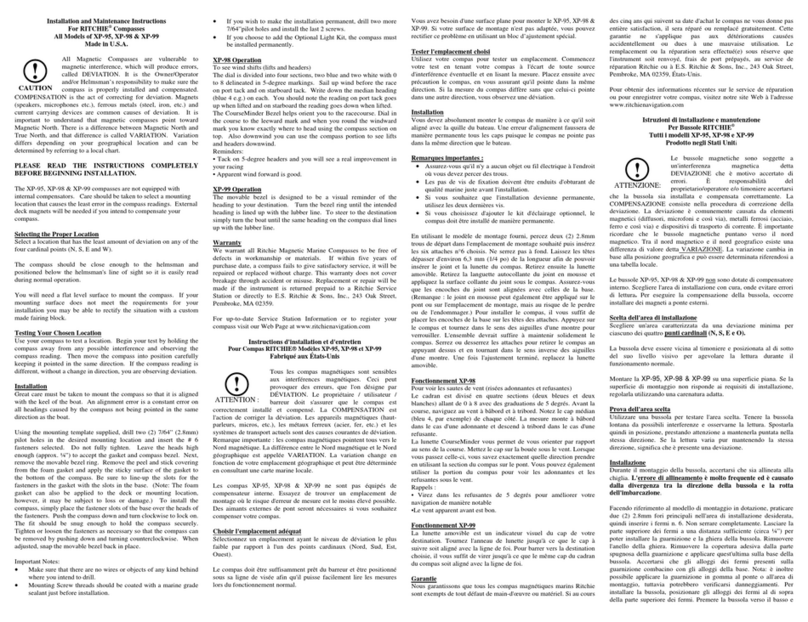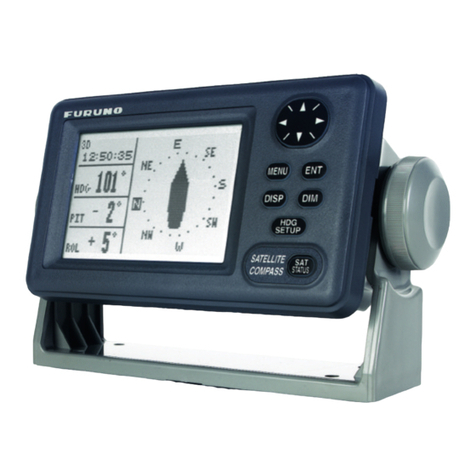ADVANSEA WIND S400 User manual

Installation and Operation Manual S400 series 1- 1 -
C.56 / T.56 / T.50
USER MANUAL
WIND/WIND-a S400
User manual
Manuel utilisateur
Other languages available on the CD-Rom or at :
Autres langues disponibles sur CD-Rom ou sur:
www.advansea.com

Installation and Operation Manual S400 series 2- 2 -
S400 advanSea instruments comply with regulations in force.
Important
It is the owner’s sole responsibility to ensure that this appliance is installed and used
in such a way that will not cause any accidents, personal injury or property damage.
The user of this appliance is solely responsible for observing safe boating practices.
Installation: if not installed correctly, the appliance will not operate to the best of its
ability. In the event of doubt, please contact your advanSea retailer. Ensure that all
holes made to mount the appliance are drilled in places without risk and that they
do not weaken the structure of the boat. If in doubt, contact a qualified boat
builder.
PLASTIMO SHALL NOT BE HELD LIABLE IN THE EVENT THE USE OF THIS
APPLIANCE CAUSES ACCIDENTS, DAMAGE OR INFRINGEMENT OF THE LAW.
Reference language: this statement, instruction and user manuals and other
information documents regarding the appliance, hereinafter referred to as
"documentation", may be translated into other languages. In the event of a dispute
regarding interpretation of the documentation, the French version shall be binding.
This manual presents the procedures for installing and operating the appliance at
the date of printing. AdvanSea reserves the right to modify the technical
characteristics of the appliance without notice.
Copyright © 2009 Plastimo, France, all rights reserved. AdvanSeaTMTM is a
registered trademark of Plastimo.
Warning

Installation and Operation Manual S400 series 3- 3 -
1 Introduction
1.1. General presentation ................................................... p.5
1.2. Components supplied with your WIND/WIND-a S400 .... p.6
1.3. Technical characteristics.............................................. p.6
2. General operation
2.1. Powering on ............................................................... p.8
2.2. Operation in normal mode ........................................... p.8
2.2.1. Selecting the type of wind
2.2.2. Selecting information
2.2.3. Resetting the max. wind speed to zero
2.2.4. Measurement units
2.2.5. Countdown timer
2.3. Alarms........................................................................ p.10
2.3.1.Setting the apparent high speed threshold
2.3.2. Setting the battery alarm threshold
2.4. Configuration.............................................................. p.11
2.4.1. Filtering
2.4.2. Calibrating the apparent wind speed (slope)
2.4.3. Calibrating the apparent wind angle (offset)
2.4.4. Selecting the pointer
2.4.5. Simulation mode
2.4.6. Key beeps
2.4.7. Resetting data in the memory
2.5. Standby...................................................................... p.14
2.6. Network operation (Bus AS-1)...................................... p.14
2.6.1. Displaying multiple data
2.6.2. Remote access
2.7. Messages ................................................................... p.15
Table of contents

Installation and Operation Manual S400 series 4- 4 -
3. Installation
3.1. NMEA 0183 interfacing.............................................. p.16
3.1.1. NMEA 0183 input interface
3.1.2. NMEA 0183 output interface
3.2. Mounting and connections ........................................ p.17
3.2.1. Mounting the Wind/Wind-a S400 unit
3.2.2 . Description of electrical connections
3.2.2.1. Bus connection
3.2.2.2. Wind vane-anemometer connection
3.2.3. Connections
4. Troubleshooting ............................................................ p.20

Installation and Operation Manual S400 series 5- 5 -
Thank you for choosing an AdvanSea product. We are convinced your S400
instrument will provide you with many safe and happy years of navigation. This
manual describes how to install and use WIND and WIND-a S400 AdvanSea
displays.
1.1. General presentation
Description of displays:
The S400 units are equipped with a large screen, and large characters for optimum
readability from all angles of vision. The analogue WIND-a display offers optimal
reading.
The window of the S400 displays is treated against condensation to prevent the
formation of mist. The screen and its keys are backlit with adjustable level.
The "WIND/WIND-a" display is designed to:
Display the apparent wind angle
Display the apparent wind speed
Calculate and display the true wind angle
Calculate and display the true wind speed
Calculate and display the max. apparent wind speed
Calculate and display the max. true wind speed
Calculate and display the VMG
- Backlighting
settings.-
Validation
- Standby
- Lower display
- Decrease
- Change units
- Upper display
- Increase
- Change units
- Alarm and
configuration
menus
Top line (32mm
characters)
Bottom line (22mm
characters)
Analogue display of
wind direction
1 Introduction

Installation and Operation Manual S400 series 6- 6 -
Acquire data through its NMEA input
Send data via its NMEA output
Exchange data on the Plastimo bus
In the event of an alarm, activate external lights and buzzers
To do so, it is supplied with 2 connection cables:
1 connector-free cable for the power supply, the bus, the NMEA IN & OUT, the alarm
output
1 LT8 cable for connection to the wind vane-gauge sensor
The WIND/WIND-a is part of the advanSea family of navigation instruments,
including instruments for measuring speed, depth, and wind. They may be
connected together to form an integrated data system for a boat (see chapter 2.6).
1.2. Components supplied with WIND/WIND-a
The WIND/WIND-a S400 display comes with (as standard):
-protective cover
-user manual
-Warranty card
-Adhesive rear sealing joint for flush mounting
The WIND/WIND-a S400 is supplied with or without a wind sensor. You can order
complete kits, or consult our website www.advanSea.com.
You will also find a complete list of accessories at www.advanSea.com
1.3. Technical characteristics
Measurement characteristics
Wind vane:
Display range: 0° to 180° port/starboard or 0° / 359°
Resolution: 1° on the digital display, 10° on the
analogue display
Configurable offset: ±180°
Anemometer:
Display range: from 0 to 199 knots
Resolution: 0.1 from 0 to 19.9 knots and 1 above
Calibration on 1 measurement point
Battery voltage:
Measurement range: from 10.0V to 16.5V
Accuracy: ±0.2V
Resolution: 0.1V
Electrical specifications
Buzzer output (green
wire):
Switched to ground, open collector, 30 V DC and 300 mA max. It
is recommended to protect this output with a 300 mA fuse.
NMEA 0183:
Version 3.01, asynchronous 4800 baud, 8 bit link, without parity,
1 stop bit. The electrical levels used on the NMEA output are
referenced to the ground and vary according to the system’s
voltage supply. .On powering on, a proprietary NMEA frame
$PNKEV, WIND V1.2*25 is sent to identify the transmitter.

Installation and Operation Manual S400 series 7- 7 -
Communication bus:
Half-Duplex 38400 baud link on one wire. Words are sent on 8
bits, without parity with 1 stop bit. The number of devices
connected to the bus is limited to 20.
Power supply:
9 volts to 16.5 volts / Consumption <150Ma
Mechanical specifications
Overall dimensions
Unit size 112mm x 112mm depth 28mm
Mounting on flat wall by means of a threaded drum of diameter
49mm, step 1.5mm and length 35mm and a plastic nut diameter
80 mm
Environment
IP66 Front panel
IP40 rear panel
Operating temperature
From -10°C to +50°C
Storage temperature
From -20°C to +60°C

Installation and Operation Manual S400 series 8- 8 -
2.1. Powering on
The WIND/WIND-a S400 display does not include an integrated switch. The unit is
powered by a 12 V DC supply on the red (+) and black (-) wires. When stopped, all
settings are memorized.
2.2. Operation in normal mode
2.2.1. Selecting the type of wind
Select the apparent or true wind data (in this case the boat speed must be received
either by the communication bus or by the NMEA input interface) by pressing
An icon "APPARENT" or "TRUE" is displayed to show the different type of wind
display.
The WIND/WIND-a display can only display the true wind if it is connected to a
speedometer or GPS.
2.2.2. Selecting information
The key is used to select various data in the lower line.
Key operation:
2 General Operation
Wind speedWind speed
VMG (if connected to speed source)VMG (if connected to speed source)
MAX wind speedMAX wind speed
Battery voltageBattery voltage

Installation and Operation Manual S400 series 9- 9 -
2.2.3. Resetting the MAX wind speed
To reset the maximum apparent wind speed, display the data on the lower display
and press and simultaneously for 2 seconds.
2.2.4. Measurement units
It is possible to choose from several measurement units to display apparent wind
speed, max. apparent wind speed, true wind speed and VMG. The table below
summarizes the various units displayed:
Data
Unit of measurement
Apparent wind speed
Knots
m/s
Miles/h
Beaufort
Max. apparent wind speed
True wind speed
Max. true wind speed
VMG
Knots
km/h
Miles/h
To change a unit of measurement:
On the lower display, select the information whose unit of measurement you want to
change, and press for 2 seconds.
The units for "apparent wind angle" and true wind angle" are always displayed in
degrees, and the battery voltage is always displayed in volts.
2.2.5. Setting the backlighting
The display and the 4 keys are backlit, with 4 levels of intensity. Level "0"
corresponds to backlighting switched off.
To control backlighting:
Press to display the backlighting page, then press
to set the backlighting level from 0 to 4.
Pressing again on the key sends the lighting level on the
bus to control backlighting on other device displays, or
automatic time out after 10 seconds for local setting.

Installation and Operation Manual S400 series 10 - 10 -
2.3. Alarms
The icon is lit when at least one alarm has occurred on one of the data
managed by the WIND display.
A sensor alarm appears when it is activated (different from 0) and the measurement
has exceeded the upper or lower threshold previously defined. This alarm is then
shown by:
The flashing icon
The data concerned by the alarm flashing,
Automatic lighting of the LCD backlighting to its highest level,
The internal buzzer sounds,
The buzzer or the external lights (if connected) are activated.
An alarm can be cancelled and inhibited for 3 minutes by pressing on any key on the
keypad. After this period, a new alarm may be triggered when the measurement
sensor once again exceeds the programmed thresholds.
Several devices interconnected on the bus, can be used to relay a sensor alarm to
other compatible displays present on the network. Example: an apparent wind speed
alarm can be viewed on all "WIND" displays present on board.
A high threshold can be set on the "apparent wind speed" and a low threshold on
"battery voltage".
2.3.1. Setting the apparent wind speed alarm threshold.
To set the high wind speed alarm:
Press
menu
, then again on
menu
until the wind speed alarm
page "SPd" is displayed, and adjust the value using the
and keys.
2.3.2. Setting the battery voltage alarm threshold.
To set the battery voltage alarm threshold:
Press
menu
, then again on
menu
until the battery voltage
alarm page "bAt" is displayed, and adjust the value using
the and keys.
Press 2 seconds to exit setup mode, or automatic
timeout after 10 seconds.

Installation and Operation Manual S400 series 11 - 11 -
2.4. Configuration
2.4.1. Filtering
A filter coefficient is available to the user for the apparent speed and angle. This
coefficient acts simultaneously on the wind indicator's angle measurement and on
the anemometer speed. This parameter can be adjusted to between 1 and 30
seconds.
To adjust the filter:
Press for 2 seconds on
menu
, then on
menu
until the "dAM" filter
setup page is displayed, then adjust the required value using
the and keys.
Press to exit setup mode, or automatic timeout after 10
seconds.
2.4.2. Calibrating the apparent wind speed (slope)
The wind speed was calibrated accurately during manufacture of the unit. However,
if you believe it is wrong, you can recalibrate it.
To calibrate the apparent wind speed, replace the speed measured by the wind
vane-gauge sensor in the calibration menu, with the speed estimated by the user (in
parallel with another instrument, hand wind gauge, etc.).
It is not possible to enter a calibration value when the apparent wind speed is equal
to "0".
To calibrate the wind speed:
Press
menu
for 2 seconds, then again on
menu
until the wind
speed calibration page "SPd" is displayed, and adjust the value
using the and keys.
Press to exit setup mode, or automatic timeout after 10
seconds.
2.4.3. Calibrating the apparent wind
angle (offset)
The apparent wind angle is calibrated by replacing the wind
angle measured by the sensor with the wind angle estimated by
the user.

Installation and Operation Manual S400 series 12 - 12 -
To calibrate the wind angle:
Press
menu
for 2 seconds, then again on
menu
until the wind indicator calibration
page "diR" is displayed, and adjust the value using the and keys.
Press to exit setup mode, or automatic timeout after 10 seconds.
2.4.4. Selecting the pointer
1 of the 4 available pointers can be selected to display the apparent wind angle in
analogue form.
To set the pointer:
Press for 2 seconds on
menu
, then on
menu
until the pointer setup page "Ptr" is
displayed, then adjust the required value using the and keys.
Press to exit setup mode, or automatic timeout after 10 seconds.
2.4.5. Simulation mode
Simulation mode is used to display coherent data which are simulated and not
measured by the sensors. When this mode is in operation, a icon appears
flashing at the bottom of the display.
In simulation mode, the following data are available:
An apparent wind speed and angle,
A true wind speed and angle,
the real supply voltage,
Transmission of simulated data via the NMEA output,
Transmission of simulated data via the communication bus.

Installation and Operation Manual S400 series 13 - 13 -
To activate the simulation mode:
Press
menu
for 2 seconds, then again on
menu
until the simulation
page « SIM » is displayed, then press to switch "ON" and
to switch "OFF".
Press to exit setup mode or automatic timeout after 10
seconds.
2.4.6. Key beeps
The key beeps can be activated or deactivated.
To activate or deactivate the key beeps:
Press
menu
for 2 seconds, then again on
menu
until the beep page
"bIP" is displayed, then press to switch "ON" and to
switch "OFF".
Press to exit setup mode, or automatic timeout after 10
seconds.
2.4.7. Resetting data in the memory
At any time, the memory of the display can be returned to factory settings. To do
so, a memory reset command is accessible in the menu.
The following parameters are restored in the memory:
Anemometer unit: Knots
Wind indicator and anemometer filtering: 10 seconds
Wind calibration coefficient: slope at 1
Gauge calibration coefficient: Offset to 0
Wind and battery alarms: deactivated, threshold at 0
Wind indicator angle (180/360): 0/180° port, starboard
Simulation mode: deactivated
Backlighting level: 0 (OFF)
To reset the memory:
Press
menu
for 2 seconds, then again on
menu
until the reset
page "RSt" is displayed, then press or to activate
the reset.
Press to exit setup mode, or automatic timeout after 10
seconds.

Installation and Operation Manual S400 series 14 - 14 -
2.5. Standby
To save energy on board, the "WIND" display can be placed on standby by pressing
for 2 seconds on the key.
Standby mode switches off backlighting, the screen, stops sensor measurement and
processing of NMEA input and output interfaces. Only the vital bus management and
keyboard functions remain active. Active displays present on the bus indicate
measurement impossible with an OFF icon instead of the data.
Standby mode is not saved. At any time, simply pressing one of the four keys
or cutting off the power stops standby mode and returns all device
functions to normal.
2.6. Network operation (Bus AS-1)
The AS-1 bus is used to connect products in the advanSea family via a rapid and
reliable exchange protocol. Only the bus wires need to be connected. No startup
settings are required.
The communication protocol allows for multiple data exchange at previously defined
transmission speeds.
Thus, it is possible:
to exchange several similar measurements on the same bus, for
example: several anemometer sources.
to change the units, the alarm threshold values or to calibrate from a
single instrument.
to activate or deactivate alarms from a single instrument.
The protocol allows exchange of similar data from different sources (direct
measurement from the sensor, or from the bus or via NMEA).
2.6.1. Displaying multiple data
In order to display multiple data, a repeater instrument (without a sensor) should be
differentiated from a measurement instrument (with a sensor or receiving NMEA
data).
A repeater instrument can display maximum 2 multiple data available on the bus
(for example: wind vane-gauge sensor no.1 and wind vane-gauge sensor no.2). If
there are more than 2 multiple data present on the bus (for example 3 wind vane-
gauge sensors), the repeater will only read the information from the 2 measurement
instruments with the lowest serial numbers.

Installation and Operation Manual S400 series 15 - 15 -
A measurement instrument (with a sensor or receiving NMEA data) will only display
the data from its own sensor or from the NMEA source received, even if other
similar data are available on the bus.
2.6.2. Remote access
A repeater instrument (without a sensor) can read and write, via AS-1 bus, all the
calibration parameters or the alarm thresholds from the same type measurer
instrument. Thus it is possible to act on the Offset of the WIND (or WIND-a) display
wind indicator connected on the bus.
System limitation:
For complex installations, with several similar measurement instruments, it is
impossible to calibrate alarms from a repeater instrument. In this case, these
settings can only be adjusted from the measurement unit (display to which the
sensor is connected).
2.7. Messages
There are 3 event messages which automatically disappear after 5 minutes or simply
by pressing a key:
Err Bat Displayed each time a power drop near the 9V threshold is detected
(safety threshold). Return to normal if the battery exceeds this security level after a
few seconds.
Err MEM Displayed on powering on if a memory malfunction occurs.
Err Bus Displayed at the first detection, after powering on, if a bus wire is
pinched (incorrect wiring).

Installation and Operation Manual S400 series 16 - 16 -
3.1. NMEA 0183 interfacing
The Wind display has one NMEA 183 input and one output, non-shielded. The NMEA
frame format recognized by the WIND display complies with the V3.01 standard of
January 2002.
3.1.1. NMEA 0183 input interface
The NMEA 183 input interface can simultaneously acquire the 4 physical
measurements listed in the table below. To avoid confusing the same data from
different frames, a 3-level priority management algorithm is used to prioritize some
frames over others.
No
NMEA data
Frames used
Priority 1
Priority 2
Priority 3
1
Boat speed
VHW
--
--
2
Speed over ground
VTG
RMC
--
3
Apparent wind angle
MWV
VWR
--
4
Apparent wind speed
MWV
VWR
--
Note: The data from the NMEA input are displayed with the icon.
3.1.2. NMEA 0183 output interface
The NMEA output interface of the WIND display emits the following 3 frames at a
rate of 1 Hz:
No
NMEA frames
Data transmitted
1
VPW
VMG
--
2
MWV
Apparent wind angle
Apparent wind speed
3
VWR
Apparent wind angle
Apparent wind speed
Note: The NMEA output does not repeat the frames received on its input. Although
the VWR frame is obsolete (replaced with the MWV in V3.01), it is emitted to ensure
compatibility with older generation instruments.
3. Installation

Installation and Operation Manual S400 series 17 - 17 -
3.2. Mounting and connections
3.2.1. Mounting the WIND (WIND-a) S400 unit
The Wind unit must be mounted in a visible location and protected from any risk of
shocks. It should be placed more than 10cm from a compass and more than 50cm
from radio or radar antenna, far from all engines, fluorescent light, alternators and
radio or radar transmitters. It should be accessible from the rear; minimum depth
cabin side 50mm. The rear panel of the unit should be protected from humidity. The
mounting surface should be flat and of thickness less than 20mm.
Drill a hole 50mm in diameter at the chosen location
Unscrew the nut located on the rear of the unit
Remove the adhesive protection around the unit
Insert and position the unit in the mounting hole
Screw back the nut
3.2.2 . Description of electrical connections
3.2.2.1. Bus connection
The bus link is provided by a 7-wire shielded cable, arranged as follows:
Red +12V DC
Black GND/NMEA-(input and output)
Orange bus
Yellow NMEA input (+)
White NMEA output (+)
Green Buzzer and external light
Blue NC
3.2.2.2. Wind vane-anemometer connection
The connection with the wind vane-gauge sensor is provided via a shielded cable
fitted with an 8-pin connector with bayonet locking.
Connector pins:
1: Bare Ground
2: Red +12V DC
3: Brown Wind indicator
4: White NC
5: NC
6: Green Anemometer
7: NC
8: NC

Installation and Operation Manual S400 series 18 - 18 -
3.2.3. Connections
Connect the wind vane-gauge sensor to the LT8 connector
Connect the - power to the black wire without connector and the red
wire to the + power via a switch and a 1A fuse.
For a system comprising several "Advansea" instruments, connect all the
orange bus wires from each instrument together.
Connect an NMEA source (GPS for example) to the yellow wire for the
+nmea and the black for the –nmea
See diagram below:

Installation and Operation Manual S400 series 19 - 19 -
menu
Capteur
anémo girouette
Alimentation 12 volts +
-
Bus
Buzzer ou
lampe
+-
Entrée NMEA
+
-
Sortie NMEA
+
-
menu
Buzzer or light
12V power supply
NMEA input
NMEA
output
Wind transducer
menu
Capteur
anémo girouette
Alimentation 12 volts +
-
Bus
Buzzer ou
lampe
+-
Entrée NMEA
+
-
Sortie NMEA
+
-
menu
Buzzer or light
12V power supply
NMEA input
NMEA
output
Wind transducer

Installation and Operation Manual S400 series 20 - 20 -
This troubleshooting guide assumes that you have read and understood this manual.
It is possible in many cases to solve difficulties without the need for the after-sales
service. Please read this chapter carefully before contacting your AdvanSea retailer.
1. The unit will not power on:
Fuse melted or circuit breaker triggered.
Voltage too low
Power cable disconnected or damaged.
2. Wind speed or direction reading wrong or incoherent:
Incorrect calibration of wind speed.
Incorrect calibration of wind alignment.
Masthead sensor cable disconnected or damaged.
Masthead dirty or damaged.
Electrical interference. Review the installation.
3. SIMU flashing on the screen, with incoherent readings
displayed.
Unit in simulation mode (see 2.4.7).
If the problems persist, we recommend you contact your retailer.
4. Troubleshooting
This manual suits for next models
1
Table of contents
Languages:
Other ADVANSEA Compass manuals


